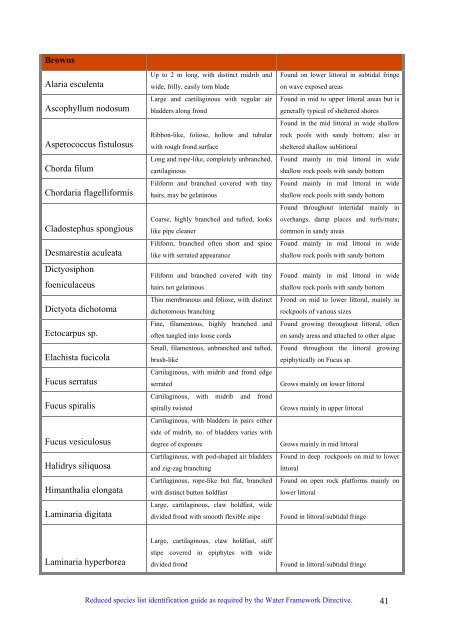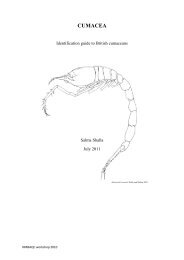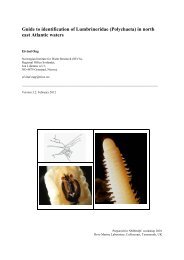s A Field Guide to the British Seaweeds - NMBAQC
s A Field Guide to the British Seaweeds - NMBAQC
s A Field Guide to the British Seaweeds - NMBAQC
You also want an ePaper? Increase the reach of your titles
YUMPU automatically turns print PDFs into web optimized ePapers that Google loves.
Browns<br />
Alaria esculenta<br />
Ascophyllum nodosum<br />
Asperococcus fistulosus<br />
Chorda filum<br />
Chordaria flagelliformis<br />
Cladostephus spongious<br />
Desmarestia aculeata<br />
Dictyosiphon<br />
foeniculaceus<br />
Dictyota dicho<strong>to</strong>ma<br />
Ec<strong>to</strong>carpus sp.<br />
Elachista fucicola<br />
Fucus serratus<br />
Fucus spiralis<br />
Fucus vesiculosus<br />
Halidrys siliquosa<br />
Himanthalia elongata<br />
Laminaria digitata<br />
Laminaria hyperborea<br />
Up <strong>to</strong> 2 m long, with distinct midrib and<br />
wide, frilly, easily <strong>to</strong>rn blade<br />
Large and cartilaginous with regular air<br />
bladders along frond<br />
Ribbon-like, foliose, hollow and tubular<br />
with rough frond surface<br />
Long and rope-like, completely unbranched,<br />
cartilaginous<br />
Filiform and branched covered with tiny<br />
hairs, may be gelatinous<br />
Coarse, highly branched and tufted, looks<br />
like pipe cleaner<br />
Filiform, branched often short and spine<br />
like with serrated appearance<br />
Found on lower lit<strong>to</strong>ral in subtidal fringe<br />
on wave exposed areas<br />
Found in mid <strong>to</strong> upper lit<strong>to</strong>ral areas but is<br />
generally typical of sheltered shores<br />
Found in <strong>the</strong> mid lit<strong>to</strong>ral in wide shallow<br />
rock pools with sandy bot<strong>to</strong>m; also in<br />
sheltered shallow sublit<strong>to</strong>ral<br />
Found mainly in mid lit<strong>to</strong>ral in wide<br />
shallow rock pools with sandy bot<strong>to</strong>m<br />
Found mainly in mid lit<strong>to</strong>ral in wide<br />
shallow rock pools with sandy bot<strong>to</strong>m<br />
Found throughout intertidal mainly in<br />
overhangs, damp places and turfs/mats;<br />
common in sandy areas<br />
Found mainly in mid lit<strong>to</strong>ral in wide<br />
shallow rock pools with sandy bot<strong>to</strong>m<br />
Filiform and branched covered with tiny Found mainly in mid lit<strong>to</strong>ral in wide<br />
hairs not gelatinous<br />
shallow rock pools with sandy bot<strong>to</strong>m<br />
Thin membranous and foliose, with distinct Frond on mid <strong>to</strong> lower lit<strong>to</strong>ral, mainly in<br />
dicho<strong>to</strong>mous branching<br />
rockpools of various sizes<br />
Fine, filamen<strong>to</strong>us, highly branched and Found growing throughout lit<strong>to</strong>ral, often<br />
often tangled in<strong>to</strong> loose cords<br />
on sandy areas and attached <strong>to</strong> o<strong>the</strong>r algae<br />
Small, filamen<strong>to</strong>us, unbranched and tufted, Found throughout <strong>the</strong> lit<strong>to</strong>ral growing<br />
brush-like<br />
Cartilaginous, with midrib and frond edge<br />
epiphytically on Fucus sp.<br />
serrated Grows mainly on lower lit<strong>to</strong>ral<br />
Cartilaginous, with midrib and frond<br />
spirally twisted<br />
Cartilaginous, with bladders in pairs ei<strong>the</strong>r<br />
side of midrib, no. of bladders varies with<br />
Grows mainly in upper lit<strong>to</strong>ral<br />
degree of exposure Grows mainly in mid lit<strong>to</strong>ral<br />
Cartilaginous, with pod-shaped air bladders Found in deep rockpools on mid <strong>to</strong> lower<br />
and zig-zag branching<br />
lit<strong>to</strong>ral<br />
Cartilaginous, rope-like but flat, branched Found on open rock platforms mainly on<br />
with distinct but<strong>to</strong>n holdfast<br />
Large, cartilaginous, claw holdfast, wide<br />
lower lit<strong>to</strong>ral<br />
divided frond with smooth flexible stipe Found in lit<strong>to</strong>ral/subtidal fringe<br />
Large, cartilaginous, claw holdfast, stiff<br />
stipe covered in epiphytes with wide<br />
divided frond Found in lit<strong>to</strong>ral/subtidal fringe<br />
Reduced species list identification guide as required by <strong>the</strong> Water Framework Directive.<br />
41




